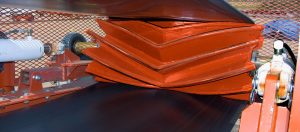
Conveyor pulleys are used on belt conveyor systems to drive, redirect, provide tension to, or help track the conveyor belt. A conveyor pulley is critical to the reliability and performance of belt conveyor systems.
That’s why selecting pulleys is a critical process – the right pulley keeps your equipment running flawlessly. If you make the wrong choice, such as choosing the wrong size of pulley, it can result in system failure and expensive downtime.
Selecting the right pulley for your system is critical, but not easy. When selecting a pulley for a belt conveyor application, a little homework is required. Here are steps that can make your decision easier and more accurate:
- Determine the face length of the conveyor pulley: The face length of a conveyor pulley is a derivative of the conveyor belt width. In bulk-handling applications, an adequate pulley face length is one that is 2 or 3 inches greater overall or 1 to 1.5 inches greater on each end than the overall width of the conveyor belt. Of course, unit handling applications may require you to deviate from these guidelines.
- Determine the anticipated belt tension of the conveyor system: Belt tension is the degree to which the conveyor belt is stretched or held tight and is typically measured in pounds per inch width (PIW). Conveyor pulleys and shafts of a larger diameter are better equipped to handle elevated levels of belt tension.
- Find the outer diameter & shaft diameter of the conveyor pulley: To properly size both the outer diameter of a pulley and select an appropriate shaft diameter, you first need to understand the key role that selection plays in avoiding the most common cause of premature failure, shaft deflection.
- Determine the style of hub connection: The hub is the mechanism that connects the conveyor pulley to the shaft. There are many types of hub connections, all of which offer individual advantages and disadvantages. Consider these things when selecting a hub connection type for a conveyor pulley: pulley position, system load, cost, maintenance and pre-stress.
- Determine the pulley configuration: The configuration of a conveyor pulley will affect its ability to effectively operate in a given environment. You should select pulley configuration based on application load requirements, environmental requirements, the intent of the pulley in the conveyor system (head/drive, tail, bend, etc.), and the type, amount and characteristics of the material being conveyed.
- Figure out the profile of the pulley face: A conveyor pulley’s profile will impact its ability to effectively track the conveyor belt. The profile of a conveyor pulley should be selected based on the need for belt tracking as well as the belt’s desired life and performance. A pulley profile may use multiple crowns on one common surface.
- Determine the appropriate component materials: Conveyor pulleys can be constructed with a variety of materials, but pulley material plays an important role in determining pulley construction and may substantially impact the overall level of pulley performance in operation.
- Determine the type of contact surface: The type of contact surface chosen for the pulley face can affect many application variables within the conveyor system. Unless an alternate surface is desired, pulleys are furnished with a plain steel or mill type finish similar to that of a standard tube or pipe. The most common contact surface modifications are those designed to increase the traction or grip between the drive pulley and the underside of the conveyor belt. In addition to providing increased traction, an alternate contact surface may be used to impact a pulley’s wear resistance, ease of cleaning and aesthetics.
Selecting the right pulley for your belt conveyor system can be tricky. If you need help, call the experts at KC Supply Co. We’ll be glad to answer any questions you may have about pulleys and belt conveyor systems, 800.KC.SUPPLY or www.kcsupply.com.


